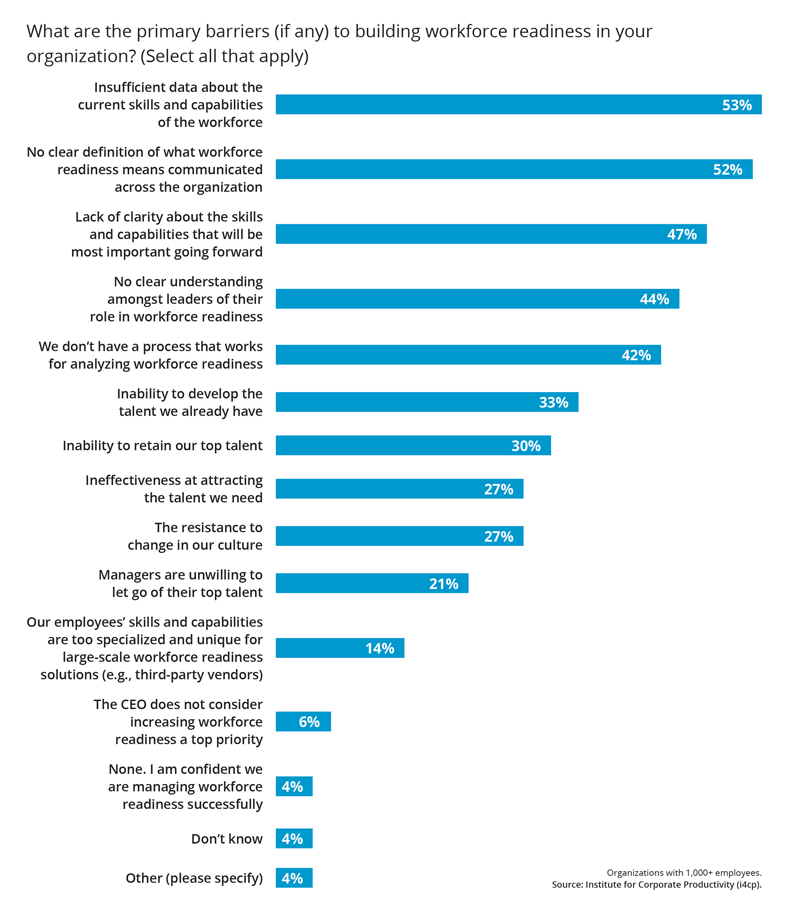Organizations are Merely Guessing in the War for Talent

Workforce readiness is, in essence, having the right people, with the right skills, in the right roles, and at the right time and place, in order to advance the organization’s strategy. Unfortunately, many organizations are merely guessing when it comes to key aspects of that equation, especially when it comes to knowing the skills and capabilities of their employees.
To win the war for talent, more workforce data is needed
The Accelerating Workforce Readiness study by the Institute for Corporate Productivity (i4cp)—our key findings brief will be published in early fall—found that only 30% of survey participants believe to a high or very high extent that their organization’s workforce currently has the skills and capabilities necessary to advance its strategy over the next one-to-three years. Participants cited insufficient data about the current skills and capabilities of the workforce as the number-one barrier to building workforce readiness.
Further, their crystal ball isn’t any clearer, as 47% of participants cited a lack of clarity about the employee skills and capabilities that will be most important going forward as being a primary barrier to building workforce readiness. In short, when it comes to talent, too many organizations don’t know what they have or what they will soon need.
You need employee skills inventories
When survey participants (from organizations with 1,000+ employees) were asked to rate their organization’s current strengths and weaknesses related to having a workforce that is ready for the future, the top characteristic by far (70%) was having a strong organizational purpose. The least often cited strength was currently adequate headcount (21%), but the second least often cited was having robust people data and analytics, with 44% stating it as an area of outright weakness (if you are in this cohort, see i4cp’s Four Ways to Advance Your People Analytics to build up this muscle for your organization).
More specifically than people data and analytics in general, less than one in five (18%) of survey participants said they currently have an employee skills database or inventory. And 8% said their organizations have such a database for critical roles, leaving only 10% that have a database with profiles for all employees. Importantly, high-performance organizations (18%) were more than 4X as likely than low-performers (4%) to already have such a broad-ranging database—and well positioned in the war for talent.
External radar has a clearer view
LinkedIn knows more about your organization’s talent than your leaders and systems do.
The responses to this question, which we posed to survey participants as a statement and asked the degree to which they agreed or disagreed with it, place a huge exclamation point on this issue. Some 28% agreed or strongly agreed, another 26% said they neither agree or disagree, and 8% didn’t know.
That is a significant admission that a third-party platform often knows more about organizations’ talent than their own leaders and systems do. Not only is this a further indication of the paucity of internal talent data, but since savvy organizations leverage LinkedIn to recruit talent and fill external pipelines, these results should really be a wake-up call for many talent leaders.
Scan the horizon for more than employee skills, experience, and education
When organizations have or are building an employee skills inventory or database, what exactly are they including in the talent profiles? Not surprisingly, survey participants indicated that technical skills, management / leadership skills, and job experience are most commonly included. Education-related information, such as college and university degrees, as well as certifications and other credentials, were cited by over 60% of participants, and languages spoken was mentioned by just over half.
Savvy organizations look beyond what their employees have accomplished so far and the skills and knowledge they have. Nearly half of survey respondents said their organization’s talent databases also include workers’ career aspirations, and over twice as many from high-performance organizations (28%) as those representing lower performers (13%) said they include the personal interests and hobbies of their employees. This makes doing so a Next Practice, which i4cp defines as a practice that correlates to strong market performance (defined by reported revenue, profit, market share, and customer satisfaction over the past five years), for the relatively few organizations that have adopted it.
Asking about hobbies, interests, and the like during hiring interviews is still frowned upon by some, as it shifts the conversation away from the role’s requirements and can introduce bias into the process. But organizations that include thoughtfully crafted questions in discussions with candidates find that they are able to put together a fuller profile of the individual. For those organizations that stick with the old-school approach, once candidates are hired, including this additional information in talent profiles (and encouraging employees to update it further) can help managers and AI algorithms identify potential career pathways, adjacent skills, and new opportunities to keep employees engaged and retention levels high.
Building up a robust people analytics function doesn’t happen overnight (to help move forward, see i4cp’s report Four Ways to Advance Your People Analytics). And more specifically, building an employee skills database—let alone maintaining its accuracy and relevance over time—is not an easy undertaking either. It might not feel like the most urgent thing to do this week, month, or quarter—but until you join the 10% of organizations that have a skills database covering all employees, you will be merely guessing in the war for talent.
View more data and insights from i4cp’s Accelerating Workforce Readiness study, available exclusively to i4cp members. The key findings brief will be available in early fall.
Thomas Stone is a Senior Research Analyst at i4cp







